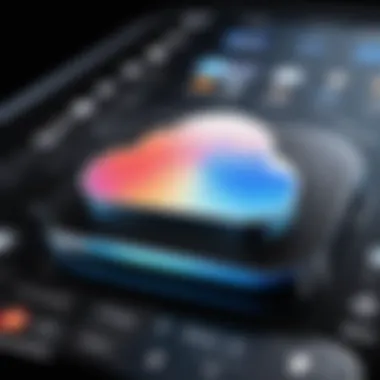Complete Guide to Deleting Photos on Your iPhone


Intro
Managing pictures on your iPhone can sometimes feel like trying to tame a wild animal. Over time, you accumulate thousands of photos, turning your device into a digital hoarder’s nest. It might be time to clear the clutter, and that's where this guide comes in handy. It’s a thorough walkthrough on how to delete all pictures from your iPhone, whether you're tired of swimming in a sea of memories or just looking for that fresh start.
In this article, we’ll explore multiple methods for erasing your photos: using the built-in Photos app, adjusting your iCloud settings, and even some third-party applications designed for this task. Each approach has its nuances—steps to follow, potential risks like data loss, and useful tips to make the process smoother.
By the end, you should feel confident about cleaning out your photo library. Time to take the plunge and reclaim valuable storage on your iPhone!
Product Overview
Key Features
- User-Friendly Interface: Apple's Photos app offers an intuitive experience. No complicated jargon or cryptic settings.
- iCloud Integration: Effortlessly keep your photos synced and manage them across devices. Just remember, what goes up may come down, so be aware of what you delete.
- Third-Party Apps: Several applications can aid you in this venture if you find native options lacking.
Specifications
- Operating System: Compatible with iOS 12 and later devices.
- Photos App Size: Varies by device but generally minimal,
- Compatibility: Works on iPhones, iPads, and iPod Touch.
Performance Analysis
Speed and Efficiency
Many users will notice that the process varies in speed depending on the method chosen. If you're using the built-in Photos app, it’s typically a smoother ride. However, deleting thousands of photos can take some time.
"Deleting your photos isn't just about speed; it's also about making sure you’re deleting what you want to, and keeping what matters."
Battery Life
Your battery usage during this operation can fluctuate, mostly depending on how many photos you’re tackling. Generally, most will find that battery drain is negligible, but it’s always wise to keep your device charged if you’re diving into substantial deletions.
The pacing of this task is not just practical—it reflects the importance of making informed decisions about what stays and what goes on your device.
Understanding iPhone Photo Management
Managing photos on an iPhone is more than just an act of storage—it's about organization, efficiency, and having a personalized digital space. When you take a moment to think about it, every picture tells a story, but eventually, some stories become irrelevant. Understanding how to handle the photo library effectively is crucial for several reasons, including storage optimization, the ability to find cherished memories quickly, and ensuring that your device runs smoothly.
The Importance of Regular Photo Cleanup
When thousands of photos accumulate, a phone can become sluggish and disorganized. Regular photo cleanup is like taking a breather for your iPhone. It allows the device to function more swiftly. Each time you scroll through endless images, it becomes harder to find that one special shot of your loved ones or a stunning sunset. By routinely deleting unnecessary photos, users can create a manageable space that not only looks better but also performs better.
This process isn't just for aesthetics—it's practical. Consider the hassle of running out of storage when trying to capture a special moment. A regular cleanup frees up space for new memories and ensures that your device remains functional, reducing the chances of crashes or slowdowns during crucial moments.
Common Storage Issues Related to Photos
Dealing with storage issues is part and parcel of owning an iPhone. Many users don't pay attention until it's too late. Here’s what you might commonly encounter:
- Insufficient Storage Notifications: Finding yourself unable to take a photo due to lack of storage? That's a classic red flag. This often pops up when too many images, especially high-resolution ones, are stored without any consideration for limits.
- Camera Roll Overload: Having excessive photos in your Camera Roll can lead to confusion about what’s worth keeping. Are those duplicate shots really necessary? It can easily lead to a chaotic photobook.
- Backups Straining Capacity: If you leverage cloud storage but have a cluttered local library, it could become hard to keep all backups organized. This can result in syncing issues and make restoring images a cumbersome task.
These storage dilemmas highlight the necessity of photo management. A proactive approach can save time and trouble down the road, helping maintain the iPhone's performance while ensuring important memories are easy to find. By understanding these complications, users can develop a strategy that not only addresses current needs but also anticipates future issues.
Preparation Steps Before Deleting Photos
Before diving into the process of deleting photos from your iPhone, it’s essential to take a few preparatory steps. This stage is like laying a solid foundation before constructing a house. Not only does it safeguard your treasured memories, but it also streamlines the whole photo deletion process. This checklist ensures your efforts won't lead to unwanted surprises or permanent loss of cherished moments. A little planning goes a long way, and understanding what’s at stake can make your photo management journey smoother.
Backing Up Your Photos
Using iCloud for Backup
Using iCloud for backup is one of the most straightforward methods available. Apple’s built-in iCloud service automatically syncs your photos across devices and keeps them safe in the cloud. It operates in the background, making it a hassle-free choice for many users.
The primary advantage of iCloud is its convenience. Your photos remain accessible on all your Apple devices, assuming you're logged into the same iCloud account. If you ever decide to do a factory reset or simply want to start fresh by deleting pictures, you can always retrieve anything you need later.


However, it’s worth noting that iCloud does have its limitations, particularly regarding storage. You get a modest 5GB for free, which can fill up quickly if you are snapping away. Beyond this, you may find yourself paying extra for additional space, which might not sit well with everyone. Still, for ease of use and reliability, iCloud remains popular among iPhone users.
External Storage Options
When it comes to external storage options, this route is increasingly seen as a viable alternative to cloud solutions. Using an external hard drive or a USB flash drive can be beneficial for those who prefer tangible storage methods. This option allows you to manually transfer photos and keep them in a physical space, away from the potentially volatile nature of cloud storage.
The standout feature here is control. Users have complete autonomy over their data without relying on an internet connection or facing storage limits imposed by service providers. The convenience of plugging in a drive and copying files doesn’t hurt either.
Nevertheless, it can come with minor downsides. For one, physical devices can be misplaced or damaged. If you’re constantly on the move or prone to forgetting things, this might not be the most reliable method to secure your memories. It’s best to weigh the pros and cons based on your lifestyle and preferences.
Third-Party Backup Solutions
Third-party backup solutions offer another layer of flexibility and often come equipped with features that can enhance your photo management experience. Apps like Google Photos and Dropbox have gained traction because they provide robust cloud storage with user-friendly interfaces. They often offer free tiers with more generous storage than iCloud, making them appealing to many.
A unique characteristic of these apps is their compatibility across various platforms, meaning you can access your photos whether you're on an Android device or a computer. This versatility is a big draw for users who switch devices or have multiple brands at home.
On the flip side, security can be a concern. Trusting a third party with your data means you need to consider their privacy policies and how they handle your information. With that said, reliable services tend to incorporate solid encryption policies. As always, it's wise to read reviews and understand the terms before fully committing.
Understanding What Will Be Permanently Deleted
Once your preparations are in place, it's crucial to understand what will be permanently deleted during the photo deletion process. Not every deletion action leads to a clear exit; some can catch people off guard. Knowing what you’re getting into, including the photos that’ll never resurface, is paramount to avoid future regrets. This stage involves a thorough grasp of your photo library and the potential impact of any deletions. Lost photos are lost for good, especially if you haven’t properly backed them up. Thus, assessing what’s truly crucial before hitting that delete button is a wise approach.
Deleting Photos Using the Native Photos App
When it comes to managing images on your iPhone, using the native Photos app stands out as a straightforward method. It offers users complete control over their media, including the ability to delete unwanted photos efficiently. Understanding how to utilize this app for deletion is critical, not only to free up storage but also to help maintain a well-organized library. By making informed choices within the app, you ensure your device remains clutter-free, improving overall performance and accessibility.
Accessing the Photos App
Accessing the Photos app on your iPhone is as simple as a few taps. You can find the app on your home screen; it’s usually on the first page along with other default applications. Just tap the icon, and you'll be greeted with your entire photo library sorted by date. Alternatively, you can swipe down from the center of the home screen and type "Photos" in the search bar, which directly leads you to the app. Once opened, you can navigate through different albums or view all photos in the library. This app is your gateway to managing your pictures, and it’s important to familiarize yourself with its layout to optimize your deletion process.
Bulk Deletion Techniques
Selecting Multiple Photos
Selecting multiple photos is one of the most efficient ways to delete images. This feature allows you to choose numerous pictures simultaneously, making it a time-saver, especially if you’re dealing with hundreds. To select multiple photos, you simply tap on "Select" in the top right corner when viewing an album. You can then touch each photo you want to delete. Once selected, a bin icon appears, enabling quick deletion.
This bulk deletion method is favored by many due to its straightforward approach; it avoids the tedious task of deleting each picture one by one. However, be cautious with this method, as selecting too many photos can lead to accidental deletion of items you want to keep. Therefore, double-check your selections before confirming the deletion.
Utilizing Album Features
Utilizing album features is another key aspect of managing photos effectively. The Photos app allows users to create albums to group images by themes, events, or any personal categorization. By organizing your images into albums, you can easily navigate through your pictures and, when necessary, delete a whole album instead of individual pictures.
The key characteristic of this feature is user customization. You can tailor your albums as you see fit, which can save time during mass deletions. When deleting an entire album, remember that this action deletes all the photos within it, so ensure you have backed up anything important.
Emptying the Recently Deleted Folder
After deleting photos from your library using the methods mentioned above, it’s crucial not to overlook the Recently Deleted folder. This folder acts as a safety net, retaining your deleted photos for 30 days before they are ultimately removed from the device. Accessing this folder is simple: just navigate to Albums and scroll to the bottom, where you’ll find the Recently Deleted option.
To clear this folder, choose the option to delete all photos at once, or select specific images you want to remove permanently. By doing this, you reclaim the storage space that was previously occupied, ensuring your iPhone operates smoothly. It’s a simple yet essential step that many users often forget, leading to unnecessary anxiety about whether their photos are really gone.
"Deleting unwanted photos not only helps free up storage but also enhances device performance and organization."
In summary, mastering the deletion process through the native Photos app can greatly enhance your experience with photo management. It’s about leveraging these features to maintain a streamlined and organized digital photo library.
Alternative Methods for Deleting Photos
In the age of digital memories, managing photographs has evolved into a necessity. While the native Photos app of iPhone offers solid features for photo deletion, exploring alternative methods can be equally important for a smoother experience. This section covers various approaches that go beyond the standard app, illustrating how users can take advantage of iCloud settings and third-party applications. These options not only serve different needs but also provide users with flexibility, efficiency, and perhaps even advanced management tools that aren’t found in the default solutions.
Using iCloud Settings
Managing iCloud Photo Library
Managing iCloud Photo Library is a pivotal strategy when it comes to organizing and deleting photos from your iPhone. One standout feature of this service is its automatic synchronization capability. Users can access their entire library across devices, ensuring that any deletion on one device reflects on all others linked through iCloud. This level of interconnectedness makes it a highly beneficial choice in the realm of photo management, especially for those who own multiple Apple devices.


However, a key characteristic to note is the storage limitations that iCloud imposes. Users get a limited amount of free storage (usually 5GB) before needing to purchase additional space. This can become a headache for those with extensive image collections, potentially leading to unexpected charges or choices about which photos to keep. Overall, while iCloud offers unique advantages, the need for additional storage often complicates decisions about managing photos.
Removing Photos from iCloud
The process of removing photos from iCloud is essential for anyone looking to streamline their storage. A significant aspect is the ability to delete photos directly from iCloud, impacting all connected devices. This characteristic not only eases the burden of manual deletion across devices but also helps in reclaiming storage space swiftly.
Users appreciate this straightforward method for its efficiency. When you remove a photo from iCloud, it often deletes it from the internal storage of the device as well, saving time and effort. However, it's vital to consider that once deleted from iCloud, these photos are not recoverable from the cloud after a certain period. Thus, ensuring backups before taking this step is crucial.
Exploring Third-Party Applications
Popular Applications for Photo Management
The landscape of photo management applications is diverse, catering to a multitude of user needs. Popular choices such as Google Photos and Adobe Lightroom stand out due to their robust features. Google Photos, in particular, offers an easy-to-use interface with powerful organizing capabilities, including automatic sorting by date and even faces, which can save a lot of hassle.
Interestingly, many of these apps provide cloud storage options, ensuring that deleted photos do not vanish irretrievably. This aspect, combined with enhanced editing tools found in apps like Adobe Lightroom, makes them attractive solutions for tech-savvy users wanting both deletion and enhancement in one package.
However, the downside to consider is privacy concerns and potential costs associated with premium features. Users should evaluate if these trade-offs align with their photo management goals.
Reviewing Features and Usability
When looking into third-party applications, reviewing features and usability is paramount. Many users find that an app’s interface can significantly impact their overall experience. For instance, an intuitive layout can make the process of deletion and organization much less cumbersome.
Some applications come with built-in guides or tutorials, making it easier for less tech-savvy individuals to navigate their features. However, while reviewing usability, it’s important to also consider how these apps handle deletion. Some may have lag times or sync issues that can lead to confusion if photos don't delete instantly as expected.
This underscores the necessity of comparing multiple options before committing to one. Often users find that the best solution might involve a mix of native options and third-party tools, balancing efficiency with ease of use.
Highlight: Always back up photos before attempting deletions through any method, whether using iCloud or third-party applications, to prevent accidental data loss.
Post-Deletion Considerations
After you’ve gone through the process of clearing out your iPhone's photo gallery, it’s essential to reflect on what comes next. The decisions made during this phase can impact how you manage your device’s storage in the future. A few significant points to consider include verifying successful deletion, restoring deleted photos if necessary, and implementing more effective management strategies moving forward.
Verifying Successful Deletion
Once you press that delete button, have you ever wondered if everything went smoothly? Verifying successful deletion means double-checking your Photos app to ensure no unwanted images are lurking there anymore. You can take a gander at the ‘Albums’ section and check if the photo counts match your expectations. If you used the Recently Deleted folder, make sure it’s cleared out, as this area can still hold onto your deleted images for a while before they're permanently zapped. Use this checklist to confirm success:
- Open the Photos app.
- Navigate to Albums.
- Check the Moments and All Photos views.
- Inspect Recently Deleted.
If everything is cleaned out, you can feel a bit lighter knowing your device now has a fresh slate.
Restoring Deleted Photos from Backups
Sometimes, despite our best intentions, we can accidentally delete something that we wish we hadn’t. If you've taken a backup prior to your deletion spree, restoring pictures becomes a simple endeavor. If you backed up your device using iCloud or iTunes, here’s a straightforward way to retrieve those cherished snapshots:
- iCloud: Go to Settings, tap on your name at the top, select iCloud, then Photos, and check if Photo Library is enabled. If so, your deleted photos might be recoverable.
- iTunes: Connect your device to your computer, open iTunes, and select your device. Look for the option that allows you to restore from a backup taken before your deletion.
People often forget they have backups, but finding out that you can restore photos can be akin to finding money in an old coat pocket.
Tips for Future Photo Management
Effective photo management doesn't just end at deletion; it's more of a continuous cycle.
Regular Maintenance Practices
Building a routine around your photo management can save you from future headaches. Regular maintenance practices include routinely going through your photos every few weeks. By doing so, you’ll keep your gallery under control and avoid large scale deletions down the line. This habit encourages discipline and helps you regularly assess what you truly want to keep.
A key characteristic of these practices is that they are easy to implement. With just a few minutes every now and then, you can stay organized. The unique feature here is the ability to develop a keen eye for what represents essential memories versus forgettable moments. It’s a habit that grows more beneficial with time.
Utilizing Cloud Storage Efficiently
Cloud storage serves as a blessing for managing large photo collections. When used efficiently, it can be a game changer. Instead of maintaining countless images on your phone, you can store them in services like iCloud, Google Photos, or Dropbox. This way, your device remains free of clutter while providing you with easy access to your favorites whenever you need them.
A notable feature of cloud storage is its accessibility. No longer confined to a single device, you can view your photos from various platforms, enhancing your experience. However, keep an eye on storage limits. Many services offer free tiers, but those can fill up quickly. Monitoring your cloud storage is essential to avoid any surprises of sudden charges or limits.


Regular audits of both your device and cloud storage bypass the stress of managing your digital memories.
Addressing Common Issues and Questions
When it comes to managing photos on an iPhone, there’s more than meets the eye. The process of deleting photos can seem straightforward, but it can also lead to a host of questions and problems that users often encounter. Addressing these common issues and queries is essential in helping users navigate the complexities of photo management, ensuring they maintain an organized photo library without unintentional mishaps.
In this section, we explore two primary issues: troubleshooting deletion problems and answering frequently asked questions about iPhone photo management. A thorough understanding of these matters can save users from a lot of frustration down the line.
Troubleshooting Deletion Issues
Photos Not Deleting
One of the more frustrating experiences for users is finding that photos won’t delete from their iPhone. This can happen due to various reasons, including software glitches or settings that prevent changes to the photo library. Knowing why this occurs is key to resolving it effectively.
The standout characteristic of this issue is that it can stem from something as simple as a lack of sufficient permissions or, conversely, a more complex software bug that needs addressing. It remains a popular topic among users because many expect deletion to occur without a hitch, making it all the more irritating when it does not.
A unique feature of this dilemma is that it can often be remedied by adjusting settings or restarting the device. Sometimes, the solution might entail updating to the latest software, as older versions may not play nice with newer features in iOS. If pictures just won't budge, consider these steps:
- Restart your device to refresh the system.
- Check your storage settings and confirm if any restrictions are in place.
- Ensure you are not attempting to delete photos that are synced from a computer or cloud service without removing them first from those sources.
These steps not only address the issue but also reassure users that a solution is often just a reboot or a change in settings away.
Storage Still Full After Deletion
Another perplexing issue that users come across is encountering a message indicating full storage even after they’ve gone on a deleting spree. This can be downright puzzling and may lead to a lot of unnecessary worry about their device’s capacity.
The key characteristic here is that deleted photos are not always immediately removed from the device's available space. When photos are deleted, they’re usually moved to the "Recently Deleted" album, where they remain for 30 days unless manually removed. Some users may forget to empty this album, leading to confusion about storage space.
This phenomenon is significant because it emphasizes the importance of understanding how deletion works on an iPhone. Deleting is not a one-and-done process; it requires follow-up action. Here’s what knowledge around this issue can provide:
- Remember to check the Recently Deleted folder and clear it out if you truly want to free up space.
- Be aware that certain applications may cache deleted photos.
- Occasionally, there may be syncing issues with iCloud which could reflect incorrect storage capacity.
Knowing these elements can empower users and save valuable time they're better off without extra anxiety.
Answers to Common Questionss About Photo Management on iPhone
The ongoing dialogue surrounding photo management also encompasses a plethora of questions that users typically have. This space serves as an informal FAQ to address typical queries, giving users a deeper insight into effectively managing and organizing their photo libraries.
A few commonly asked questions include:
- How can I retrieve deleted photos?
- Why is my iCloud not syncing with my photos?
- Can I delete photos in bulk across my devices?
- To restore images, you can navigate to the Recently Deleted album and select the photos you wish to recover. Alternatively, using a backup can also help.
- This could be due to a faulty network connection or iCloud settings. Ensuring that your device is connected to Wi-Fi and iCloud Photo Library is enabled may resolve this.
- Yes, as long as the iCloud Photo Library is enabled, changes made on one device will reflect on the others.
Closure
In navigating the digital landscape of our iPhones, managing photo storage can be not just a task, but a necessity. The ability to delete pictures is crucial for maintaining optimum device performance and ensuring that users can easily access the photos that truly matter. This article emphasizes the importance of regularly cleaning up your photo library, which helps keep your device running smoothly and avoids the frustration of a cluttered gallery.
Summarizing Key Points
Throughout this guide, various methods for deleting photos have been outlined, focusing on both native tools and alternative options:
- Native Photos App: Using the built-in app allows for straightforward bulk deletion and enables users to empty the Recently Deleted folder to ensure complete removal.
- iCloud Management: By managing settings competitively, it provides a seamless experience for those who prefer cloud storage.
- Third-Party Applications: Applications like Geminis Photos and PhotoSweeper can simplify the process, especially for those with extensive libraries.
"Regularly managing your photo library can prevent regret later on!"
By reviewing the protocols of deleting all pictures, readers can protect their devices from storage-related pitfalls. Understanding what is permanently deleted and the significance of good practices is essential here. Regular cleanup not only declutters but can also make way for new memories.
Encouraging Ongoing Management Practices
Moving forward, it is crucial for users to adopt ongoing management practices.
- Establish Regular Cleanups: Set reminders to go through photos at least once every month or so. Even a quick check can save future headaches.
- Utilize Storage Tools: Make full use of the available tools, such as iCloud or Photos apps, to keep track of your digital footprint.
- Consider Utilizing Albums: Organize photos into albums to make it easier to see what to delete when the time comes. This step can not only boost efficiency but also reduce decision fatigue during cleanup sessions.
By integrating these practices into one’s digital routine, users will not only enjoy more space but also have peace of mind. Ultimately, regular maintenance of your photo library is not just a technical task; it's an opportunity to curate your digital memories mindfully.



